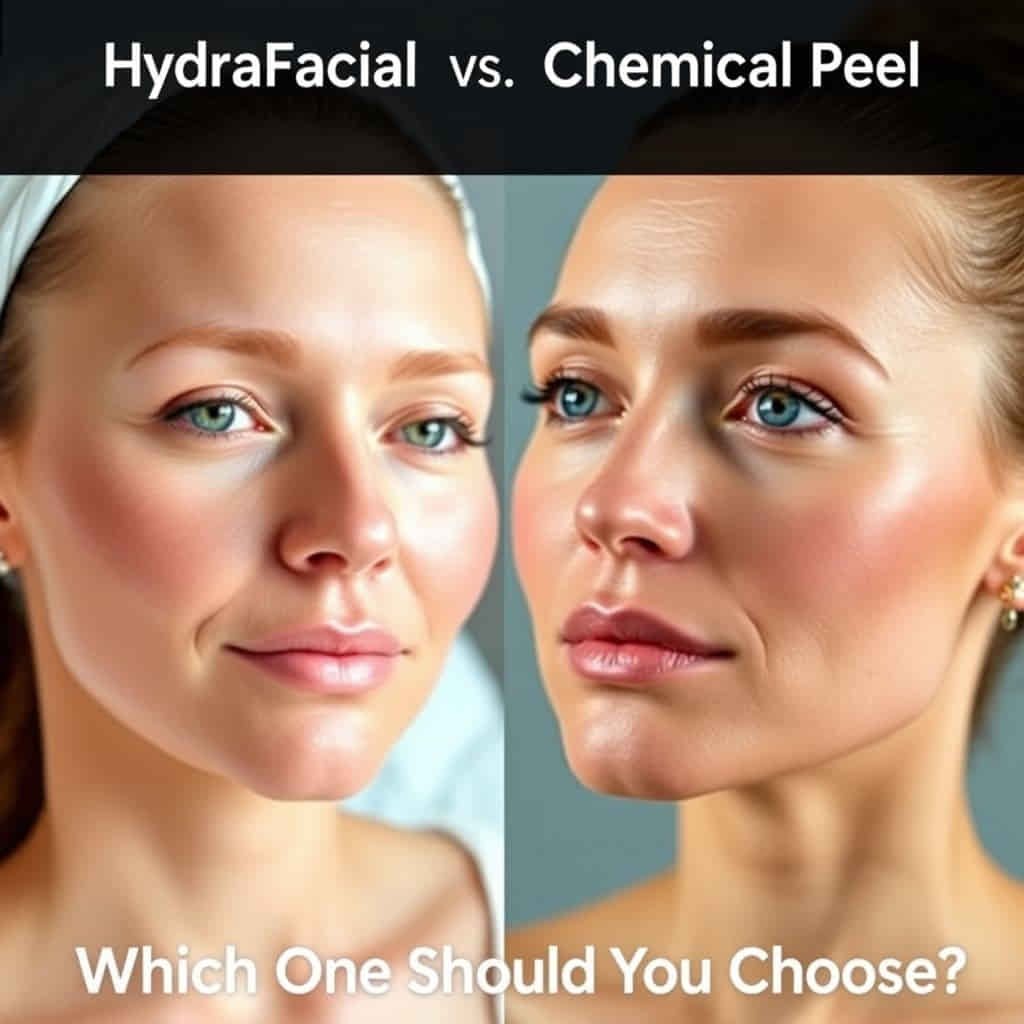HydraFacial vs. Chemical Peel: Which One Should You Choose?

A glowing, healthy complexion isn’t just about skincare routines at home—sometimes, professional treatments at a med spa in Pittsburgh are the key to achieving radiant skin. Two of the most popular non-invasive facial treatments are HydraFacials and Chemical Peels, each offering unique benefits. But which one is right for your skin type and concerns?
This in-depth guide compares HydraFacial vs. Chemical Peels, covering their differences, benefits, and ideal candidates. By the end, making a confident decision about your next medical spa visit in Pittsburgh will be easy.
What Is a HydraFacial?
A HydraFacial is a multi-step facial treatment that cleanses, exfoliates, and hydrates the skin using a specialized device. It’s often considered the go-to treatment for those seeking an instant glow without irritation or downtime.
How It Works
The treatment follows a three-step process:
- Cleanse & Exfoliate – Removes dead skin cells and debris.
- Extract & Hydrate – Uses a vacuum-like suction to clear clogged pores while infusing moisture.
- Fuse & Protect – Nourishes skin with antioxidants and peptides for a youthful glow.
Key Benefits of HydraFacial
One of the biggest advantages of a HydraFacial is that it is painless and non-irritating. Unlike traditional facials that may cause redness or discomfort, this treatment is gentle on the skin. Additionally, results are immediate—expect a bright, hydrated complexion as soon as the treatment is finished. There is no downtime required, meaning you can return to your daily routine right away. Another major benefit is that the treatment can be customized based on your specific skin concerns. Whether dealing with acne, fine lines, or hyperpigmentation, serums used during the HydraFacial can be tailored to target these issues.
Best For:
HydraFacials are ideal for individuals with dry, dehydrated skin that needs deep hydration. Those with clogged pores and mild acne-prone skin can also benefit from this treatment, as it gently removes impurities without harsh chemicals. It’s also a great option for those with sensitive skin that cannot tolerate aggressive exfoliation. If you have a big event coming up and want a quick, refreshing boost, a HydraFacial is an excellent choice.
What Is a Chemical Peel?
A Chemical Peel is a skin resurfacing procedure that uses an acid-based solution to remove dead skin layers, encouraging new skin growth. The depth of the peel can be adjusted to target specific concerns.
How It Works
During a chemical peel, a specialized solution is applied to the skin to promote exfoliation. Depending on the depth of exfoliation required, there are different types of chemical peels:
- Superficial Peels provide light exfoliation using alpha-hydroxy acids (AHAs) to brighten and smooth the skin.
- Medium Peels penetrate deeper and help address concerns such as pigmentation, wrinkles, and acne scars.
- Deep Peels are more intensive, designed to treat severe sun damage and deep scarring.
Key Benefits of Chemical Peels
Chemical peels offer significant improvements in skin texture by reducing fine lines, acne scars, and rough patches. They are particularly effective in fading hyperpigmentation, including dark spots, age spots, and melasma. Additionally, chemical peels stimulate collagen production, which helps improve skin elasticity and gives a firmer, youthful appearance. For those struggling with acne, certain peels containing salicylic acid can help reduce breakouts and minimize scars.
Best For:
A chemical peel is best suited for individuals with oily and acne-prone skin needing deep exfoliation. It is also an excellent choice for treating sun damage and hyperpigmentation, as well as for those looking to reduce fine lines and wrinkles. If you have acne scars or an uneven skin texture, chemical peels can significantly enhance the skin’s overall appearance.
HydraFacial vs. Chemical Peel: Key Differences
While both treatments help improve skin health, there are significant differences between them.
When it comes to pain levels, HydraFacial is completely painless and feels like a soothing, gentle facial, while chemical peels may cause mild to moderate stinging depending on the strength of the peel. In terms of downtime, HydraFacials require no recovery time, allowing individuals to resume their daily activities immediately. Chemical peels, on the other hand, may require anywhere from three to seven days of recovery, depending on the depth of the peel.
Regarding skin type compatibility, HydraFacials are safe for all skin types, even those with sensitive skin. Chemical peels, however, are best suited for normal to oily skin and are particularly beneficial for acne-prone or sun-damaged skin.
The results timeline also varies between the two treatments. A HydraFacial delivers an instant glow, while chemical peels offer progressive improvements over time as the skin continues to shed old layers.
In terms of treatment duration, HydraFacials take approximately 30 to 45 minutes, while chemical peels can range from 30 to 60 minutes depending on the depth of the peel and the specific skin concerns being addressed.
When considering which treatment is best for specific concerns, HydraFacials are ideal for hydration and mild exfoliation, making them perfect for those looking for a quick glow. Chemical peels, on the other hand, are more effective at addressing acne, hyperpigmentation, and aging concerns such as fine lines and wrinkles.
Which One Should You Choose?
Choosing between a HydraFacial and a Chemical Peel depends on your skin type, concerns, and desired results.

Opt for a HydraFacial if:
- Your skin is sensitive or prone to redness.
- You want instant hydration with no downtime.
- You have a big event coming up and need a quick skin boost.
Opt for a Chemical Peel if:
- You need deeper exfoliation to tackle acne scars, fine lines, or hyperpigmentation.
- You’re okay with a few days of downtime for long-term skin renewal.
- Your skin is oily and can tolerate acids.
Not sure which is right for you? A professional skin consultation at a Pittsburgh med spa can assess your skin and recommend the best treatment.
What to Expect Before & After the Treatment
HydraFacial Experience
Before a HydraFacial, no special preparation is required. During the treatment, clients experience a cool, gentle sensation, similar to a light massage. Afterward, the skin immediately looks refreshed, glowing, and hydrated, with no irritation or downtime. Makeup can be applied right away if desired.
Chemical Peel Experience
Before a chemical peel, individuals should stop using retinoids and exfoliating products a few days prior to avoid excessive irritation. During the procedure, a mild tingling or warmth may be felt as the solution works on the skin. Afterward, peeling and redness typically occur for several days as the skin renews itself, revealing fresh, smoother skin beneath.
Finding the Best Med Spa in Pittsburgh
Selecting the right med spa in Pittsburgh is crucial for safe, effective treatments. Consider the following when booking a session:
✔ Licensed and experienced providers – Ensure the med spa is staffed by certified professionals.
✔ Customized treatment plans – A good med spa personalizes treatments to your skin needs.
✔ High-quality products and technology – Advanced skincare tools and medical-grade ingredients lead to better results.
✔ Client reviews and reputation – Check online reviews and before-and-after photos for credibility.
Looking for a trusted medical spa in Pittsburgh? Schedule a consultation with a qualified skincare specialist to discuss the best option for your skin.
Final Thoughts
Both HydraFacials and Chemical Peels offer excellent skin benefits, but their effectiveness depends on individual skin needs. If a quick, hydrating refresh is the goal, a HydraFacial is ideal. For deeper skin correction like acne scars or pigmentation, a Chemical Peel is the way to go.
For expert guidance, book a consultation at a top-rated med spa in Pittsburgh and start your journey toward healthier, more radiant skin.
